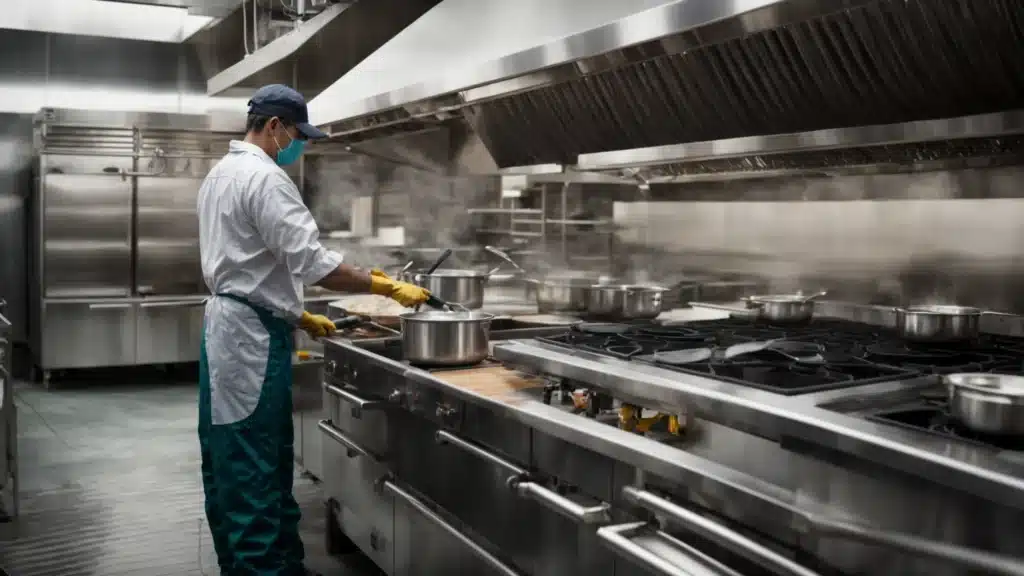Ensuring Safety: Regular Grease Hood Cleaning in Eateries
In the bustling heart of every eatery, where flames dance and dishes come to life, lies a hidden sentry of safety—the grease hood.
Its role, often unsung, involves guarding against the dangers of fire by trapping grease, smoke, and airborne debris that ascend from the fervor of cooking.
Yet, the efficacy of this vigilant protector dwindles without regular cleansing, turning it from a shield into a potential hazard lurking above chefs and patrons alike.
Recognizing the signs of a grease hood in dire need of attention and mastering the art of its cleaning are crucial chapters in the larger story of kitchen safety.
Keep reading to unravel the secrets to ensuring your eatery’s kitchen remains a beacon of safety and efficiency, free from the clutches of fire risks.
Commercial Kitchen Grease Hood Cleaning Essential Steps and Frequency
Key Takeaways
- Regular Grease Hood Cleaning Is Essential to Prevent Fire Hazards and Ensure Employee Wellbeing
- Neglected Kitchens Can Quickly Become Dangerous Environments Due to Accumulated Grease Acting as Fuel for Potential Fires
- A Well-Maintained Exhaust System Contributes to Superior Indoor Air Quality, Benefiting Both Kitchen Staff and Patrons
- Establishing a Routine Inspection and Cleaning Schedule Adheres to Safety Regulations and Maintains the Kitchen’s Operational Integrity
- Engaging Professional Cleaning Services Provides Specialized Expertise and Equipment, Ensuring Safety and Hygiene Standards Are Exceeded
Understanding the Importance of Grease Hood Cleaning
Toronto Hood Cleaning
At the core of restaurant safety and hygiene, regular grease Hood Cleaning emerges as a pivotal factor, intricately linked to preventing potential fire hazards and ensuring the wellbeing of employees.
Recognizing the risks associated with neglect invites a closer examination of how accumulated grease can transform a kitchen from a bustling heart of culinary creativity into a tinderbox awaiting a spark.
Furthermore, the influence of a well-maintained exhaust system extends beyond fire prevention, playing a crucial role in sustaining superior air quality.
This not only contributes to a healthier environment for kitchen staff but also enhances the overall dining experience, underscoring the undeniable correlation between meticulous cleaning practices and the vitality of the establishments they protect.
Recognizing the Fire Hazards Associated With Neglect
The ghost of neglect hovers like a dense fog over kitchens where grease hood cleaning is overlooked, transforming these culinary havens into unwitting incubators for fire hazards. Accumulated grease acts as a formidable fuel, eager to ignite under the right circumstances, turning a minor oversight into a catastrophic event that can endanger lives and dreams alike.
It is an irrefutable fact that a kitchen’s neglect serves as a silent summon to disaster, with uncleaned hoods whispering invitations to potential fires. These risks crystallize into a grim reality when a stray spark from cooking or electrical fault dances with the accumulated grease, setting the stage for a blaze that can rapidly consume the heart of any establishment.
The Impact on Air Quality and Employee Health
A kitchen without proper exhaust system cleaning is akin to a stagnant pond-the air, dense with grease, circulates a cocktail of contaminants, reducing indoor air quality dramatically. This environment acts as a breeding ground for bacteria and traps odors, which can lead not only to discomfort among the kitchen staff but also to significant health issues over time.
Improved air quality through diligent grease hood cleaning becomes a breath of fresh air, literally and metaphorically, for those working tirelessly behind the scenes. Ensuring the removal of hazardous pollutants and odors from the kitchen atmosphere fosters a healthier, more vibrant workspace, and in turn, contributes to mitigating absenteeism and enhancing productivity. The act of cleaning thus becomes a cornerstone for safeguarding both the physical and mental wellbeing of employees.
Now that we’ve illuminated the critical role of grease hood cleaning, let’s pivot to the next vital step. Detecting the signs that signal it’s time for a thorough cleanse is our next adventure.
Identifying When Your Grease Hood Needs Cleaning
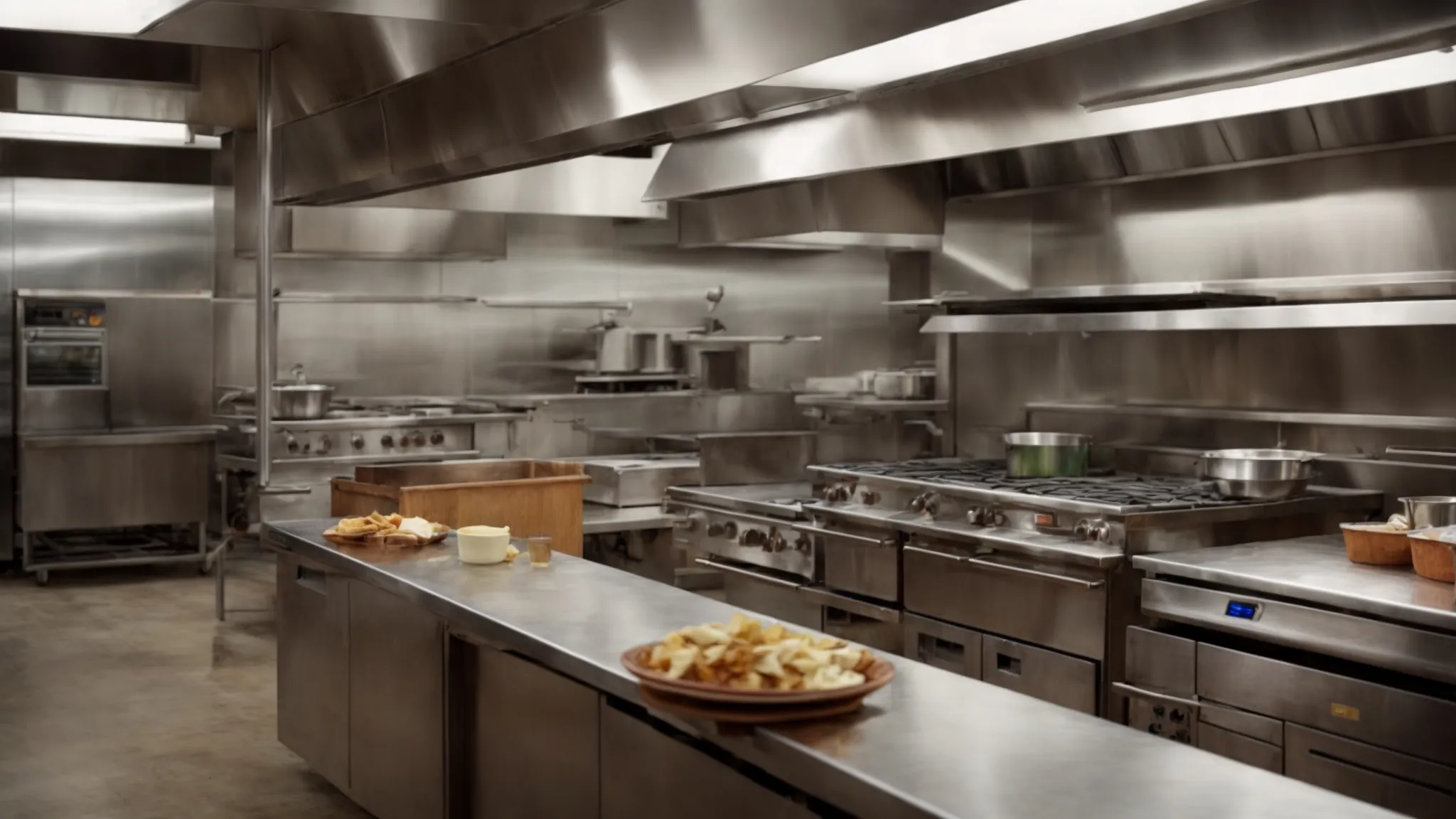
Unearthing the early warning signs of grease accumulation in your hood system acts as the frontline defense against the shadow of fire risks and air quality degradation.
The journey towards kitchen safety and optimal hygiene commences with a critical eye for spotting visible signs of grease buildup, intertwined with the establishment of a routine inspection schedule.
This dual approach not only champions preventive measures but also embeds a culture of accountability and meticulousness within the heart of culinary operations.
Embarking on this path sheds light on the importance of regular maintenance, a guardian against the hazards lurking within unattended nooks and crannies of commercial kitchens.
Spotting Visible Signs of Grease Buildup
The onset of grease accumulation whispers a silent warning, manifesting as a sticky residue that clings to the surfaces of the hood and kitchen equipment. This palpable film, a telltale sign of the need for immediate intervention, signals that the kitchen’s beating heart is shrouded in a layer of flammable peril, awaiting thorough cleansing.
Visibility of grease marks on filters, walls, and the underside of the hood serves as a glaring red flag, urging restaurant owners to heed the call for a professional cleaning session. This scenery of grease-laden surfaces, if not addressed, transforms a kitchen from a sanctuary of gastronomic creations into a potential fire-ground, underscoring the imperative of prompt exhaust system maintenance.
Setting a Routine Inspection Schedule
Just as the captain of a ship regularly checks for signs of wear and tear to prevent catastrophe, so must restaurant owners establish a routine inspection schedule for their grease hoods. This systematic approach ensures that potential risks are identified and addressed before they escalate into larger problems:
| Frequency | Area of Inspection | Action Required |
|---|---|---|
| Monthly | Grease Filters | Clean or Replace |
| Quarterly | Exhaust System Ducts | Professional Deep Cleaning |
| Semi-Annually | Entire Hood System | Inspection by Certified Specialists |
| Annually | Fire Suppression System | Inspection and Certification |
This calendar of vigilance serves as a bulwark against the accumulation of grease and other contaminants that threaten safety and hygiene. Adhering to such a schedule not only keeps the kitchen environment healthy but also complies with the regulations set forth by the National Fire Protection Association (NFPA) and local authorities, maintaining the establishment’s standing as a beacon of cleanliness and safety.
The journey from recognition to resolution brims with anticipation. Let’s embark on discovering the perfect cleaning alchemy for your culinary sanctuary.
Choosing the Right Cleaning Methods for Your Eatery

Embarking upon a culinary adventure entails more than crafting delectable menus; it necessitates a steadfast commitment to safety and cleanliness, at the heart of which lies the pivotal task of grease hood cleaning.
Choosing the right cleaning method for your eatery becomes a balancing act between efficiency and thoroughness, a decision further complicated by the diverse options available.
With the goal to maintain the delicate harmony between operational demands and safety standards, evaluating the merits of chemical versus manual cleaning options offers a starting point.
Further, considering professional cleaning services emerges as an essential step, ensuring that the methods employed not only align with industry standards but also with the unique needs of each establishment.
This section sheds light on navigating these choices, ensuring that eateries can uphold the highest levels of safety and hygiene without compromising their culinary artistry.
Evaluating Chemical Versus Manual Cleaning Options
In the theatre of commercial kitchens, the choice between chemical and manual cleaning options strikes a chord akin to choosing between steel and velvet. Chemical cleaning, wielding its potent arsenal of degreasers and detergents, promises a swift vanquishing of grease and contaminants, penetrating even the most obstinate layers with a vigorous efficiency. Yet, its use necessitates a keen understanding of the specific concoctions appropriate for different surfaces, to prevent the irony of safeguarding one’s kitchen from fire hazards while inadvertently inviting corrosion or material degradation.
On the flip side, manual cleaning stands as the stalwart guardian of tradition, involving elbow grease powered by brushes, sponges, and the determined human spirit. This method, steeped in the tangible satisfaction of physical labor, allows for meticulous attention to detail but demands a substantial investment of time and effort. The balance between these two realms of cleaning – chemical’s zealous firepower and manual’s meticulous march – is punctuated by the need to tailor the approach to the eatery’s specific demands, ensuring that the armor against grease-induced perils remains both unbreachable and pristine.
Considering Professional Cleaning Services
Embarking on the quest for impeccable cleanliness within an eatery’s kitchen often leads to the crossroads of deciding between in-house efforts and enlisting professional cleaning services. The latter, with its crew of trained specialists, brings to the table a level of expertise and equipment that transcends the limitations of what traditional methods could achieve, ensuring a kitchen environment that not only meets but surpasses safety and hygiene standards.
Professional cleaning services possess the unique advantage of offering customized solutions tailored to the distinct needs and challenges of each eatery. This personalized approach, coupled with adherence to stringent industry regulations and the application of environmentally friendly cleaning techniques, elevates the restaurant’s standing in the eyes of both inspectors and patrons, crystallizing the relationship between cleanliness and the establishment’s reputation for excellence.
Armed with knowledge about the right cleaning strategies, it’s time to roll up our sleeves. Dive into the nitty-gritty world of DIY grease hood cleaning with our comprehensive guide.
Step-by-Step Guide to DIY Grease Hood Cleaning
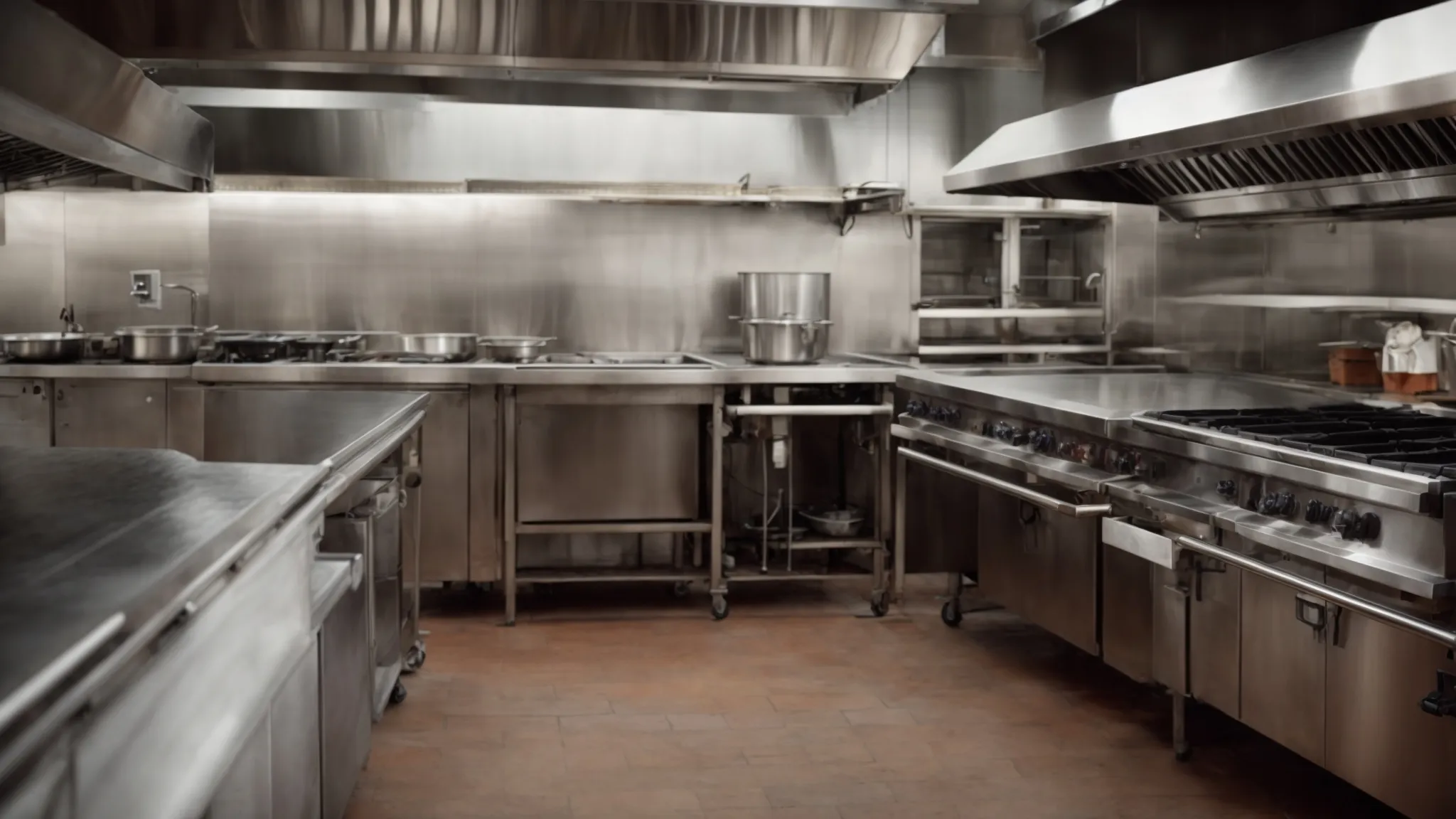
In the heart of every eatery, where flavors enmesh with fervor, the grease hood stands as a silent sentinel against hazards.
Yet, its efficacy is tethered to the regularity and thoroughness of its cleaning.
The journey towards ensuring safety in commercial kitchens begins with a meticulous preparation of the arena and its tools.
This preparation involves not just the gathering of cleaning agents and equipment, but also an understanding of the spaces that crave attention.
Following this, the detailed process of degreasing your hood system unfolds in stages, each critical to stripping away the filmy residues of culinary battles past.
This step-by-step guide aims to navigate the intricacies of grease hood cleaning, ensuring that eatery owners can uphold the twin pillars of operational safety and hygiene without faltering.
Preparing Your Kitchen and Equipment for Cleaning
Before the cleansing symphony can commence, setting the stage involves ensuring the kitchen sphere is prepared, a task equivalent to laying out a blank canvas. This preliminary step entails powering down all cooking appliances and covering the kitchen’s surfaces—countertops, cooking equipment, and floor—with a protective layer, akin to laying a protective shield against the chaos of battle, ensuring no errant splashes of degreaser or detergent mar the aesthetic of the space.
Secondly, assembling the arsenal required for this meticulous campaign against grease involves gathering cleaning solutions ranging from environmentally friendly degreasers to sponges, brushes, and microfiber towels designed to tackle the stubbornness of accumulated oil without leaving behind any scratches on the stainless-steel surfaces. Each tool is carefully selected, embodying the precision of a master artist, ready to breathe cleanliness back into the heart of the kitchen.
Detailed Process of Degreasing Your Hood System
The voyage into degreasing your hood system starts with a mixture of determination and the right concoction of degreasers: a beacon, guiding the way towards cleanliness and safety. Armed with environmentally friendly detergents that cut through the grime without compromising the integrity of the metal, the battle against grease begins, not with a clang, but with the whispered promise of restoration.
Following the initial assault on the grease, the methodical cleanup operation takes on a rhythm of its own:
- Apply the degreaser generously over the hood, ensuring coverage over all greased areas.
- Allow the solution to sit, letting the chemical agents break down the stubborn grease, transforming it from a formidable foe to a manageable task.
- Scrub vigorously with brushes and sponges, paying extra attention to the corners and edges where grease likes to hide.
- Rinse with hot water, watching as the remnants of the battle against grease flow down the drain, leaving behind a gleaming surface.
- Dry the area with microfiber towels, absorbing every droplet of water to prevent the irony of water spots tarnishing your victory.
This step-by-step strategy not only ensures a thorough cleanse but also fortifies the kitchen’s defenses against future invasions of grease and grime, positioning the establishment as a paragon of hygiene and safety in the culinary realm.
Mastering the art of grease hood cleaning is a feat akin to conquering a kitchen Everest. Let’s elevate our ambitions, turning our focus to the peak of prevention to ensure this triumph endures.
Implementing Preventative Measures Post-Cleaning
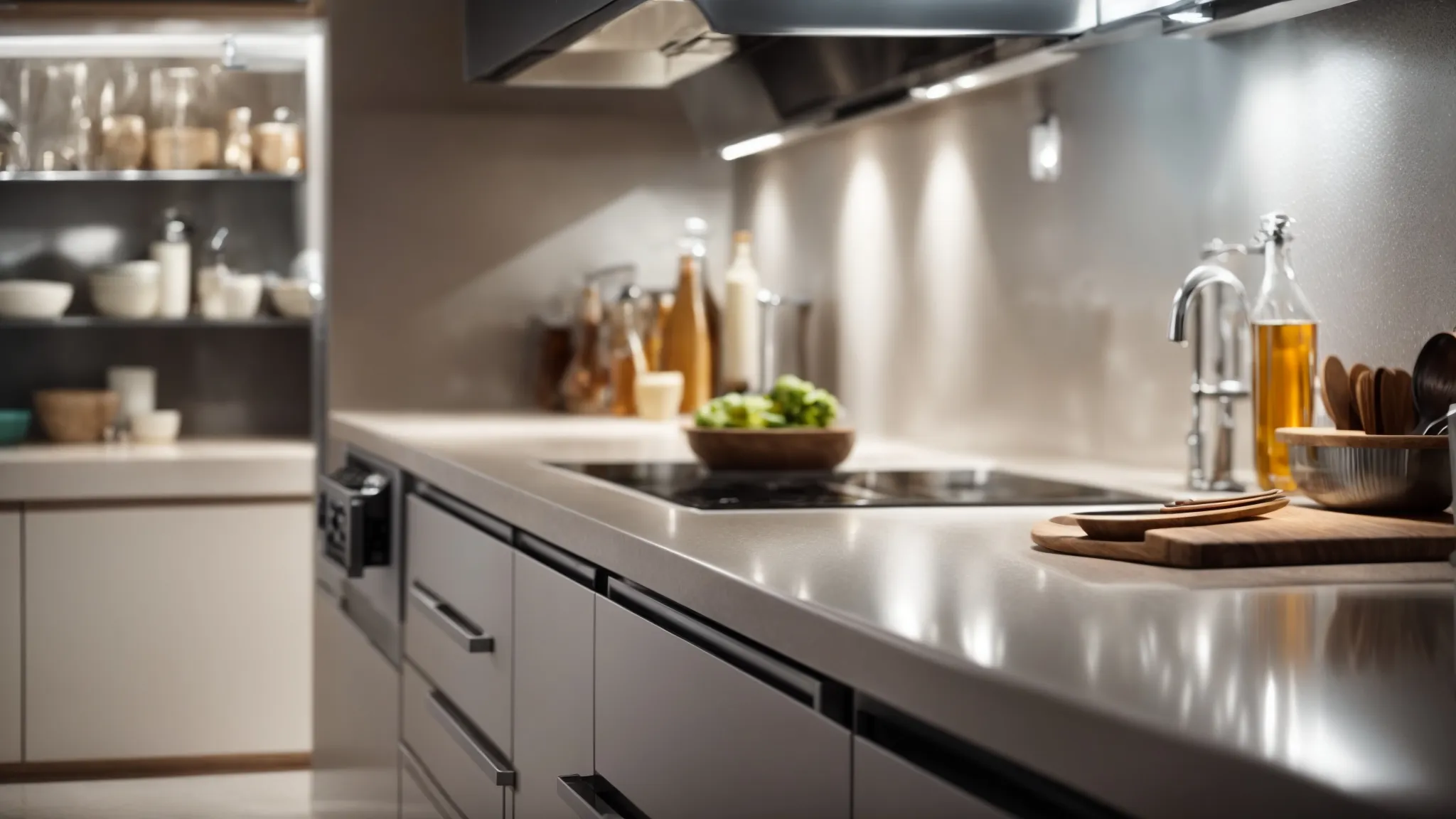
In the aftermath of battling against the relentless tide of grease and grime, a kitchen stands renewed, its defenses bolstered by meticulous cleaning.
Yet, the conquest of cleanliness does not culminate with a single endeavor; it ushers in the crucial phase of implementing preventative measures post-cleaning.
As the culinary arena returns to its pulsating rhythm of creation, embracing regular maintenance tips becomes the sentinel guarding against the resurgence of grease buildup.
This proactive strategy not only promises the prolongation of a kitchen’s pristine state but also cements a culture of vigilance and care, ensuring the safety and hygiene of the eatery remain indomitable against future challenges.
Regular Maintenance Tips to Minimize Future Buildup
In the wake of a rigorous cleaning, establishing a schedule for regular inspections and cleanings emerges as a crucial step in maintaining the sanctity of an eatery’s kitchen. This continual vigilance ensures that grease and debris do not accumulate to levels that pose a risk, thereby safeguarding the establishment from potential hazards and preserving the integrity of its operations.
Adopting daily cleaning protocols for surfaces and equipment exposed to grease, such as the usage of specific degreasers and proper disposal methods for grease-laden materials, fortifies a kitchen’s defenses against the encroachment of contaminants. This proactive approach not only extends the lifespan of kitchen equipment but also upholds a standard of cleanliness that is reflective of the eatery’s commitment to safety and excellence. An effective exhaust system is essential in maintaining a safe kitchen environment.
In the aftermath of a thorough grease hood cleansing endeavor, the focus shifts to embedding preventative strategies within the daily operations of an eatery. The establishment of routine maintenance protocols acts as a bulwark, ensuring that the threat of grease accumulation is kept at bay, hence upholding the kitchen’s sanctity against future safety hazards.
Engaging in regular monitoring and swift action upon the slightest detection of grease ensures that the eatery’s defenses remain impregnable. This proactive stance not only extends the efficiency of the ventilation system but also anchors the establishment’s repute in the bedrock of health and safety compliance.
With the battlefield of grime and grease now behind us, the path ahead promises a brighter, cleaner horizon. Let’s march forward, embracing the shine and safeguarding our culinary kingdoms.
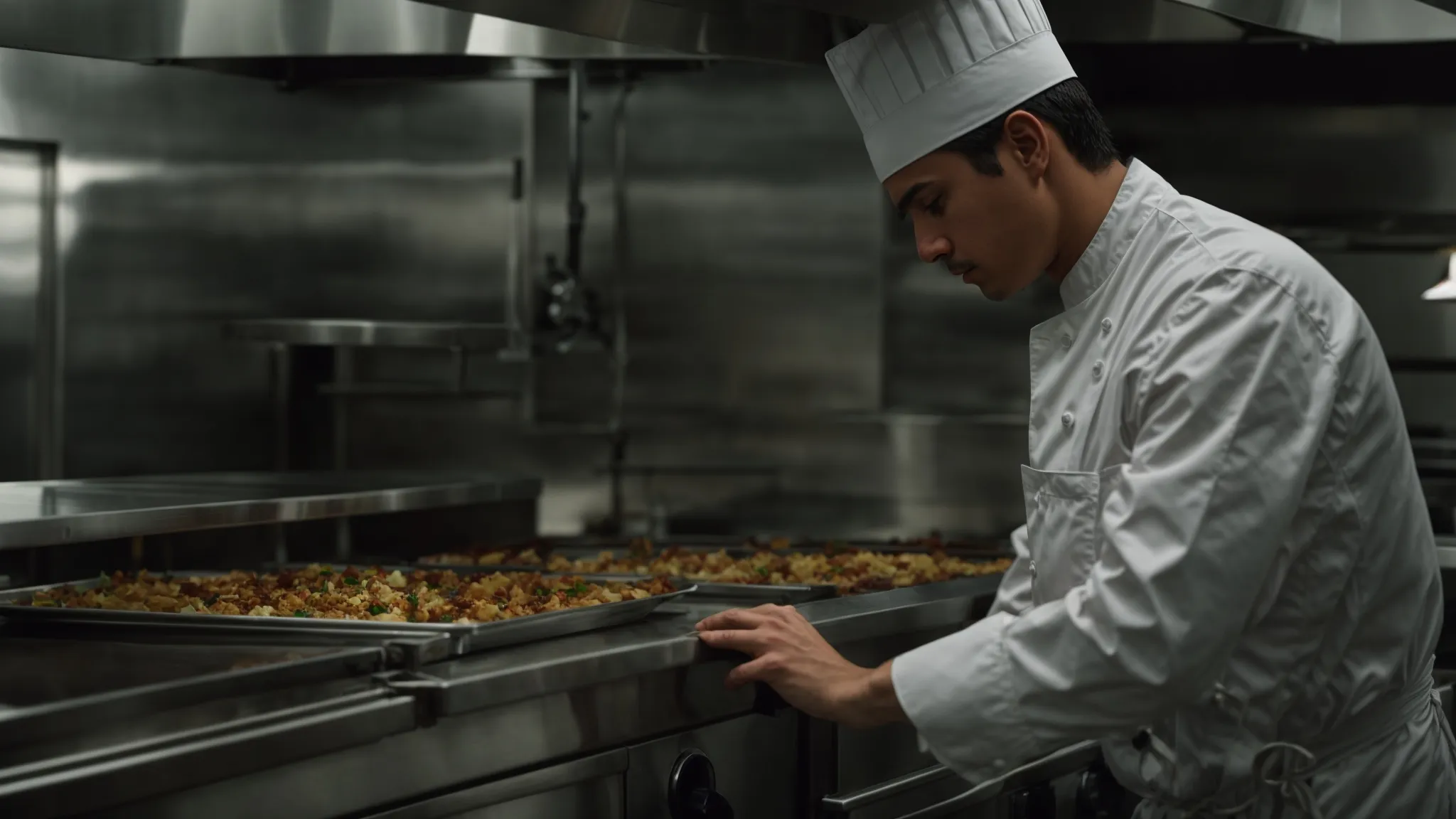
In the heart of every bustling eatery, the grease hood operates silently, its importance often underappreciated until the dire consequences of neglect become glaringly evident.
Regular grease hood cleaning, therefore, emerges not just as a routine chore but as a critical safeguard against the lurking dangers of fire hazards and air contamination.
This section peels back the layers on why such maintenance is non-negotiable, delving into the intricacies of ensuring both employee and patron safety through vigilant practices.
A closer look at effective cleaning techniques and the undeniable benefits of engaging professional services will underscore the vital role that grease hood hygiene plays in the overall health of a restaurant’s operation.
In the bustling world of culinary establishments, the vigilance in maintaining grease hood cleanliness becomes a linchpin for ensuring safety and upholding hygiene standards. The diligence of implementing regular grease hood cleaning protocols shields eateries from the looming specter of fire hazards, underscoring the inextricable link between cleanliness and operational security.
Through the meticulous removal of grease accumulation, restaurants fortify their defenses against potential ignition sources, effectively turning the tide against risks that threaten the wellbeing of both patrons and staff. This practice not only manifests as a commitment to safety but also serves as a testament to an eatery’s dedication to creating a pristine dining environment, thereby elevating the diner’s experience and fostering trust within the community it serves.
In the realm of restaurant operation, the importance of regular grease hood cleaning transcends mere maintenance; it embodies a crucial preventive measure against the perils of fire hazards. This diligent practice ensures that layers of grease, which could act as fuel in the event of a fire, are methodically removed, thereby significantly minimizing the risk of catastrophic events.
Moreover, the commitment to scheduled grease hood maintenance stands as a testament to an establishment’s dedication towards ensuring a safe and hygienic environment. Not only does it safeguard the well-being of both patrons and staff, but it also reinforces the restaurant’s reputation as a responsible community member:
- Commence with a thorough assessment of the grease accumulation within the hood system.
- Implement a regular cleaning schedule, aligning with industry best practices and local regulations.
- Engage in meticulous cleaning procedures, employing both chemical and manual techniques where applicable.
- Conclude with a post-cleaning inspection to ensure that the grease hood is entirely free of contaminants.

